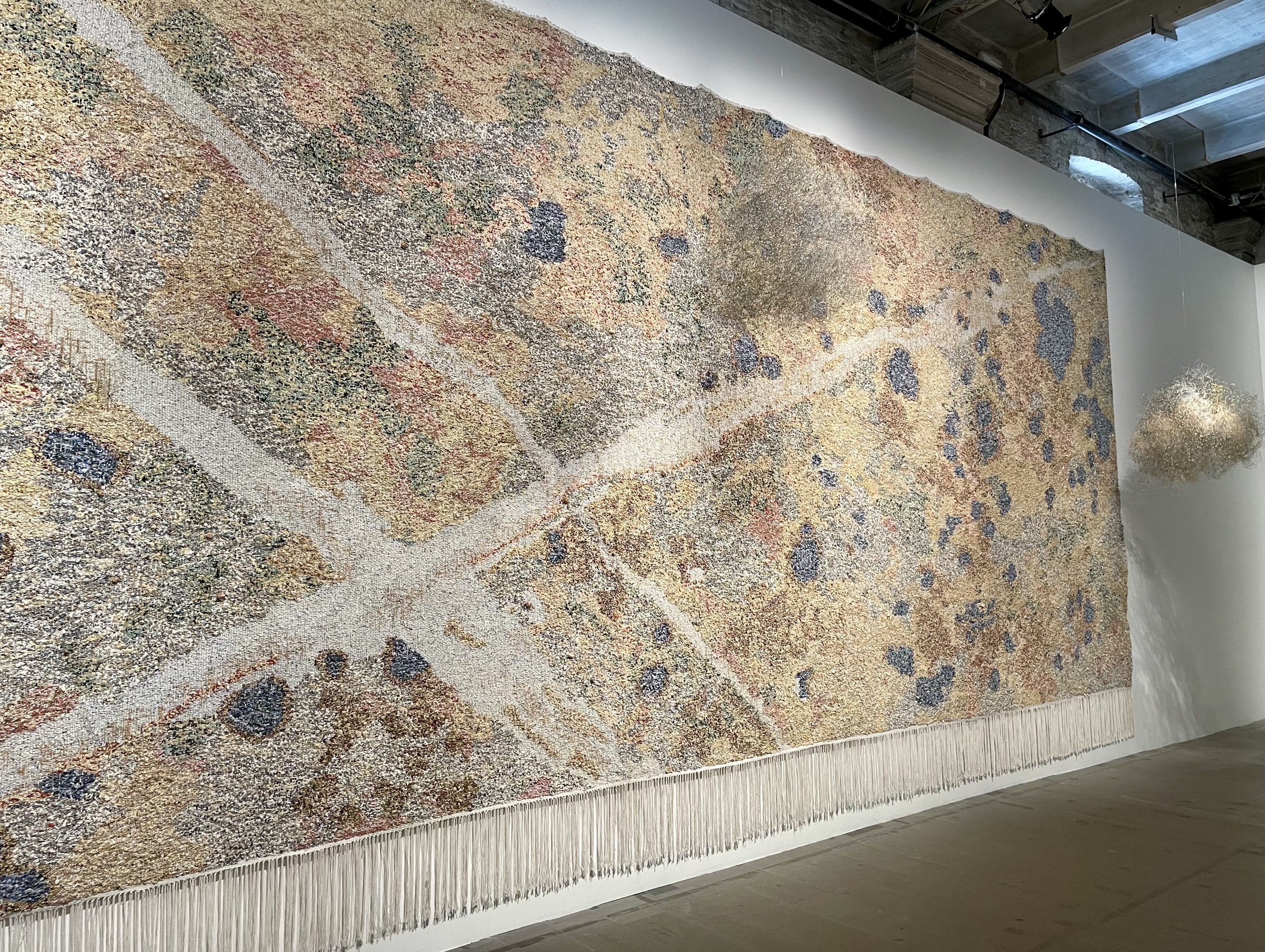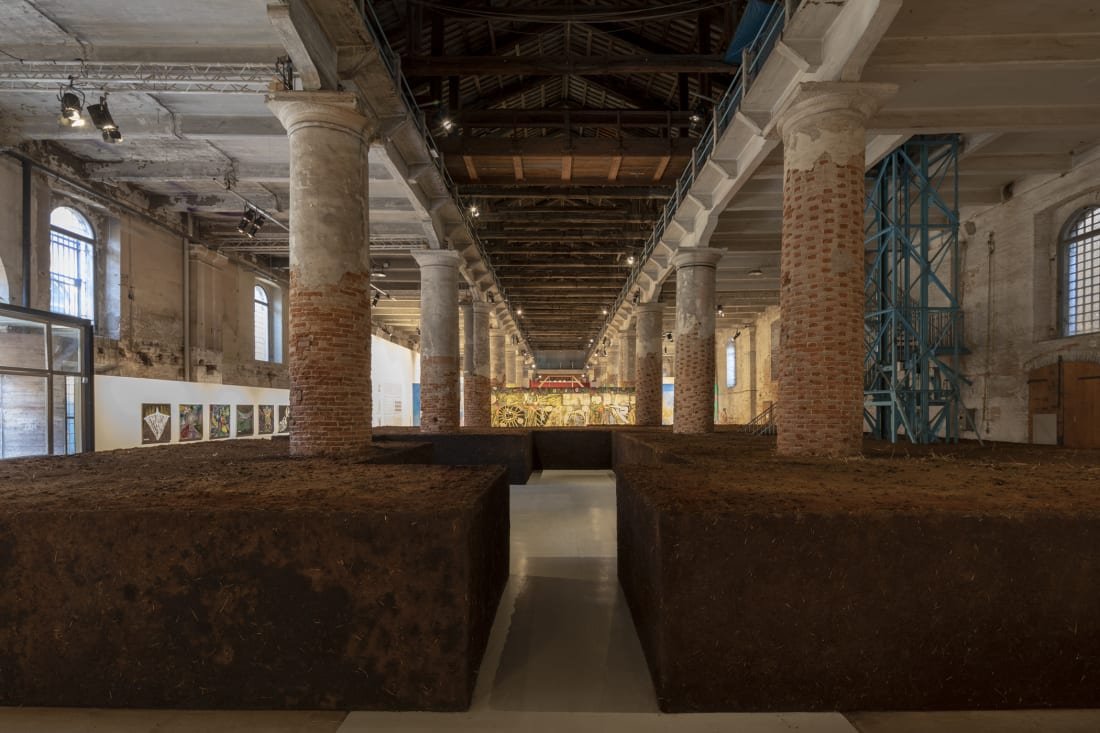A trip to….Venice Biennale
We had a whirlwind trip to Italy that included experiencing this year’s magical and highly acclaimed Venice Biennale, curated by Cecilia Alemani, also marking the first time an Italian woman has curated the program. Georgia knows the city very well, having lived there as part of her degree, so we were able to zoom around, stopping for an occasional Campari spritz, Cicchetti and gelato to beat the heat.
This year’s exhibition, The Milk of Dreams, is titled and inspired from a 1950s fairytale by the surrealist artist Leonora Carrington. The book is set in a “magical world where life is constantly re-envisioned through the prism of the imagination (…) where everyone can change, be transformed, become something or someone else.” The ambitious display, featuring 213 artists from 58 countries, is spread out through the Central Pavilion in the Giardini and the neighboring Arsenale shipyard, nearing half a mile in length. Also responding to this mystical theme were the 80 National Participations taking place in the historic Pavilions and throughout the city.
We were blown away by the installations and welcomed the presence of those that have been historically excluded from such arenas—the largest biennale showcasing the work of women, queer, and artists of color. Collectively, they came together to present a powerful overarching sense of resilience, not to be masked by the devastation caused by the ongoing war just across the continent in Ukraine, and the shootings and politics in the United States. In the wake of unsettling events, we were empowered by art’s ability to adapt, protest and inspire more than ever.
While we didn’t have time to see everything, here are our top picks starting with the National Participations.
Denmark :
Uffe Isolotto, We Walked the Earth, curated by Jacob Lillemose.
This deeply haunting installation made us both gasp as we turned the corner. The artist Isolotto states “I transformed the entire pavilion into an apparent idyllic Danish farmhouse, but once you enter the setting you encounter a haunting drama of life and death personified by a hyperrealistic family of centaurs.” With a damp feeling and faint smell of grass, the pavilion takes you through the lifecycle of a family of three centaurs. The installation was complex and unpredictable; you couldn’t help but make a comparison to the present time in the world that we are living in.
Ghana : Na Chainkua Reindorf, Afroscope, Diego Araúja, Black Star - The Museum as Freedom, curated by Nana Oforiatta Ayim.
Under the patronage of Ghana’s President Nana Addo Dankwa Akufo-Addo, the exhibition is titled after the Black Star that symbolizes the Ghana Flag and some of its most important monuments such as the Black Star Gate. The symbol has become an icon representing the connection between Africa and its diasporas through Jamaican political activist Marcus Garvey and his resulting Back-to-Africa movement. The Black Star now goes beyond Ghana; it is symbolic of all people of African descent wishing to make their way home to the continent. The mediums showcased are diverse, from works on canvas to sculpture, symbolizing freedom across time, technology and borders. The exhibition also highlights the curator Nana Oforiatta Ayim’s concept of the Mobile Museum, which travels into communities across Ghana with the goal of creating accessible, contextual and inclusive spaces.
France :
Zineb Sedira, Dreams Have No Titles, curated by Yasmina Reggad, Sam Bardaouil, and Till Fellrath.
The French pavilion is transformed into an enchanting cinematic installation, built around the Algerian independence movement of the 1960s. Viewers are engaged by themes of family, decolonization and racism through sculpture, film, photography and music. As the first artist of Algerian descent to represent France at the Biennale, Zineb Sedira brings extensive cinema research together with her own family history and experiences in Algeria, France, and England, in this semi-autobiographical work. By walking through reconstructions of sets from classic films and Sedira’s own home, she considers personal as well as political events and the fusion of influences that keep culture alive. One film playing in the living room even features her friend in the neighboring British pavilion, Sonia Boyce.
Great Britain : Sonia Boyce, Feeling Her Way, curated by Emma Ridgway.
Sonia Boyce’s Golden Lion winning pavilion presents an installation that expands on her work Devotional Collection (1999–present), which contains over 20 years of research across three centuries, honoring Black female musicians. The work uses vinyl records, CDs, posters, images, ticket stubs, and more, placed against a captivating gold wallpaper and plinths to create devotion altars. The history and the impact of Black women can be felt through sound and color in this interactive experience. As the first black female artist to represent Britain at the Biennale, she has made invisibility a focus of her art, and this installation is no exception. In an interview with the New York Times earlier this year she said “To be the first suggests that there wasn’t space for anyone like me before,” adding that she hopes “the door stays open for more to come through.” To really get a feel for this monumental installation, watch the video below.
© The British Council.
Poland :
Małgorzata Mirga-Tas, Re-enchanting the World, curated by Joanna Warsza and Wojciech Szymański.
This pavilion was a joy to experience; the craftsmanship and detail of twelve large textiles two stories high had immediate impact. Małgorzata Mirga-Tas’s tapestries allude to the “Hall of the Months” frescos from the Renaissance Palazzo Schifanoia in Ferrara, Italy. This marks the first time a Roma artist is representing a national pavilion in the over 120-year history of the Venice Biennale. The Romani, colloquially known as Roma, are a group of people who originated in Northern India, predominantly living in Europe and the Americas. The installation challenges stereotypes and presents an insightful picture of a Roma community, also drawing attention to the role women have played in Romani history. The scale of the piece makes an essential task such as a doing laundry feel monumental, and while the work is a joy to look at, the feeling is bittersweet, as in recent years freedom of expression has been increasingly under attack in Poland.
USA :
Simone Leigh, Sovereignty, Curated by Eva Respini.
We have been long time fans of Simone Leigh’s work and it is wonderful to see her heavily represented at this year’s Biennale. Leigh’s monumental sculptures reinvent the lives and lost histories of Black women across the diaspora. As the first black woman to represent her country in the US pavilion; the 1930s concrete building has been transformed to look like a thatched traditional west African structure. She was the recipient of the Golden Lion for best participation in the Biennale’s central exhibition, The Milk of Dreams, which included her 16-foot-tall bronze sculpture Brick House (2019). The curator, Eva Respini, explains that Leigh’s work serves as an “’incomplete archive’ of Black feminist thought, with works inspired by leading Black intellectuals. Her work insists on the centrality of Black female forms within the cultural sphere, and serves as a beacon in our moment.”
Next, here are our top picks from the central exhibition spread out in the Giardini and Arsenale.
Igshaan Adams, Bonteheuwel/Epping, 2021.
Igshaan Adam’s large-scale tapestries made from locally sourced materials, are inspired by the geometric patterns of linoleum floors found throughout Cape Town; reflecting on commodity trading in postcolonial Africa.
Ruth Asawa, Hanging Eight Separate Cones, 1952.
The late Ruth Asawa’s iconic ethereal sculptures highlight the connection between the interior and exterior surfaces of the work, a relationship that the artist long described as interdependent and integral. She was a pioneer who overcame tremendous racial, gender, and class prejudices in her lifetime.
Felipe Baeza, Wayward, 2021.
Originally from Mexico and currently living in Brooklyn, Felipe Baeza’s paintings present “his dreams of other planets and other ways of looking at life” in the form of bodies undergoing transformation; half-human and half-plant.
The Witch’s Cradle, 2022.
This installation, which curator Alemani calls the show’s “fulcrum,” is devoted to women Surrealists who used themes of fantasy to deconstruct male stereotypes. Artists featured include Amy Nimr, Remedios Varo, Leonor Fini, and, of course, Leonora Carrington.
The Witch’s Cradle in The Milk of Dreams, 59th Venice Biennale, 2022. Photo: Marco Cappelletti; © La Biennale di Venezia
Noah Davis, The Conductor, 2014.
Noah Davis’ The Conductor, is from a series focused on the “Garden City” Pueblo del Rio in Los Angeles, built by Richard Neutra, Paul R Williams and more in 1941. The painting depicts a man in a tuxedo conducting an unseen orchestra, representing the potential of art and performance in a low income community.
Safia Farhat, Gafsa & Ailleurs, 1983.
Colorful hand spun tapestries by Tunisian artist, educator and activist Safia Farhat feature a blend of geometric shapes and figurative forms depicting fantastical narratives. She uses weaving as an expression of the reforming spirit of her time.
Kudzanai-Violet Hwami, Wedding of the Astronauts, 2022 series.
Kudzanai-Violet Hwami’s paintings draw on her years growing up in Zimbabwe and South Africa to examine the ways we exist together and experience one another in an increasingly digital world. She is one of the four recipients of the grant for the inaugural edition of Biennale College Arte, launched in 2021.
Delcy Morelos, Earthly Paradise, 2022.
Delcy Morelos’ site specific installation is a maze of mud and soil infused with hay, cassava flour, cacao powder and spices. Curator Manuela Hansen eloquently states the work “conveys the notion that nature is not something inert that we access and control at our will from an outside and exceptional position, but that we are earthly beings – we become, live, die, and decompose with and as the earth.”
Delcy Morelos, Earthly Paradise, 2022. Photo: Roberto Marossi.
Paula Rego Installation.
This room, filled with Paula Rego’s figurative sculpture and paintings, was especially poignant as she recently passed away in June and you couldn’t help by feel her presence. The trailblazer’s work confronts the viewer with human relationships and the social, sexual, emotional dynamics that often define them.
Works by Paula Rego. Photo: Roberto Marossi; © La Biennale di Venezia.
Unless credited, all images taken by CURA Art, 2022.















